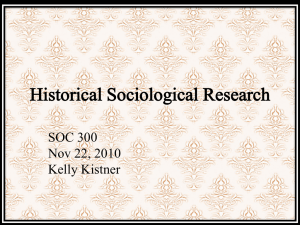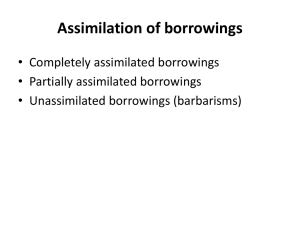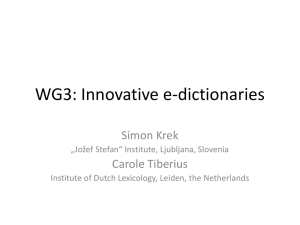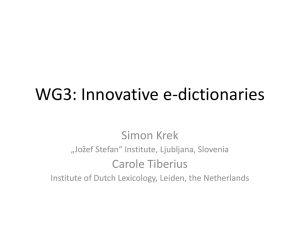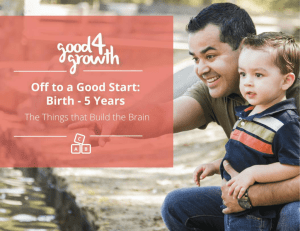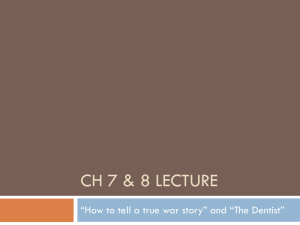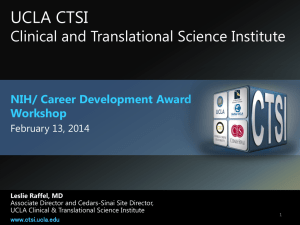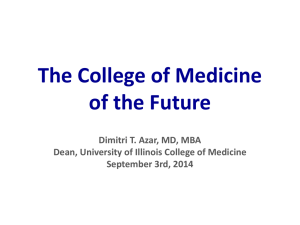Linking Etymological Database: A case study in Germanic
advertisement
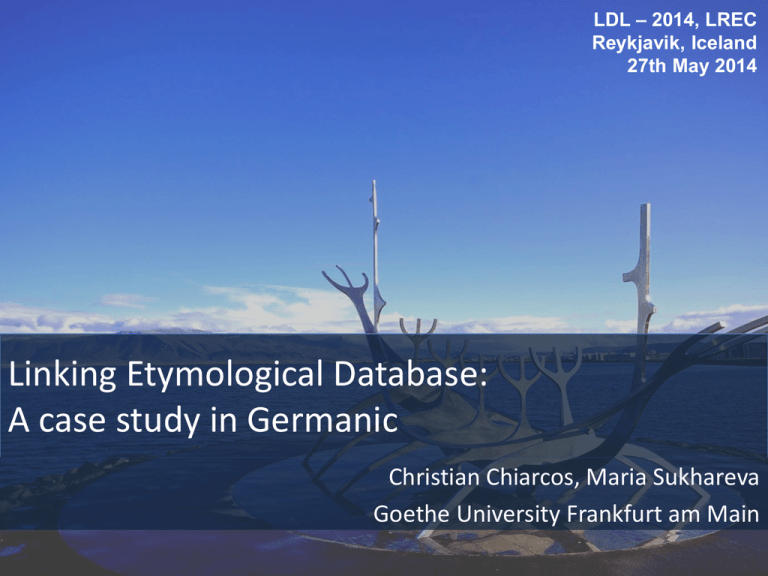
LDL – 2014, LREC Reykjavik, Iceland 27th May 2014 Linking Etymological Database: A case study in Germanic Christian Chiarcos, Maria Sukhareva Goethe University Frankfurt am Main Overview 1. 2. 3. 4. 5. Background Linked Etymological Dictionaries Enriching of Linked Etymological Dictionaries Application Conclusion Background Background Processing of Old Germanic Languages at Goethe University Frankfurt, in collaboration between: ACoLi Lab 1. Empirical Linguistics Thesaurus of Indo-European Text and Language Materials (TITUS) TITUS 2. ACoLi Lab (Applied Computational Linguistics) 3. LOEWE Cluster “Digital Humanities” 4. DFG-funded Old German Reference Corpus (DDD) DDD Referenzkorpus Althochdeutsch Linked Etymological Data Linked Etymological Data Linked Etymological Data Conversion of etymological dictionaries to RDF • Linkability: representation of relations within and beyond lexicons • Interoperability: (meta)data representation through community-maintained vocabularies (lexvo, Glottolog, OLiA, lemon) • Inference: filling the logical gaps of the original XML representation – Symmetric closure of cross-references Linked Etymological Data all language identifiers were mapped from the original abbreviations and assigned ISO 6393 codes wherever possible. lemonet:translates a relation between lemon:LexicalEntrys lemonet:etym links between languages, transitive and symmetric. Subproperty of lemon:lexicalVariant Linked Etymological Data Original XML (lemma) RDF Triples Symmetric closure of etymological relations generated by SPARQL pattern Links to external resources Enriching Etymological Dictionaries Enriching Etymological Dictionaries Germanic parallel Bible corpus (parentheses indicate marginal fragments with less than 50,000 tokens) Enriching Etymological Dictionaries 1. Statistical word alignment of parallel texts (GIZA++) 2. Lexical translation tables as basis for the extracted word lists: • Unidirectional: maximum of P(wt|ws) • Bidirectional: maximum of P(wt|ws) ∗ P(ws |wt) 3. Pruning by frequency Application Application Thematical Alignment of Bible paraphrases – E.g., cross references within the Bible and between the Bible and gospel harmonies • an interlinked index of thematically similar sections in the gospels and OS/OHG gospel harmonies – OS Heliand and OHG Tatian section level alignment (Sievers, 1872) has been digitized – 4560 inter-text groups based on the Eusebian canon • Basis for a more fine-grained level of alignment Application similarity metrics δ(wOS;wOHG) for every OS word wOS and its potential OHG cognate wOHG Character-based similarity measures: – GEOMETRY: δ = difference between the relative positions of wOS and wOHG – IDENTITY: δ(wOS;wOHG) = 1 iff wOHG = wOS (0 otherwise); – ORTHOGRAPHY: relative Levenshtein distance & statistical character replacement probability (Neubig et al., 2012) – NORMALIZATION: norm(wOS;wOHG) = δ(w’OS;wOHG) , with w’OS being the OHG ‘normalization’ (Bollmann et al., 2011) – COOCCURRENCES: δ(wOS;wOHG) = P(wOS|wOHG)P(wOHG|wOS) Lexicon-based similarity measures: δlex(wOS;wOHG) = 1 iff wOHG 2 W (0 otherwise) where W is a set of possible OHG translations for wOS suggested by a lexicon, i.e., either: ETYM: etymological link in (the symmetric closure of the etymological dictionaries, ETYM-INDIRECT: shared German gloss in the etymological dictionaries, TRANSLATIONAL DIRECT: link in the translational dictionaries, TRANSLATIONAL INDIRECT: indirectly linked in the translational dictionaries through a third language. Application similarity metrics δ(wOS;wOHG) for every OS word wOS and its potential OHG cognate wOHG Character-based similarity measures: – GEOMETRY: δ = difference between the relative positions of wOS and wOHG – IDENTITY: δ(wOS;wOHG) = 1 iff wOHG = wOS (0 otherwise); – ORTHOGRAPHY: relative Levenshtein distance & statistical character replacement probability (Neubig et al., 2012) – NORMALIZATION: norm(wOS;wOHG) = δ(w’OS;wOHG) , with w’OS being the OHG ‘normalization’ (Bollmann et al., 2011) – COOCCURRENCES: δ(wOS;wOHG) = P(wOS|wOHG)P(wOHG|wOS) Lexicon-based similarity measures: δlex(wOS;wOHG) = 1 iff wOHG 2 W (0 otherwise) where W is a set of possible OHG translations for wOS suggested by a lexicon, i.e., either: ETYM: etymological link in (the symmetric closure of the etymological dictionaries, ETYM-INDIRECT: shared German gloss in the etymological dictionaries, TRANSLATIONAL DIRECT: link in the translational dictionaries, TRANSLATIONAL INDIRECT: indirectly linked in the translational dictionaries through a third language. Conclusion & Discussion Conclusion 1. Application of Linked Data Paradigm to modeling of etymological dictionaries 2. Adopting of Lemon core model 3. Representation of Köbler’s dictionary in a machine-readable format 4. Enriching etymological dictionaries by automatically obtained translation pairs 5. Initial experiment on usage of dictionaries for quasi-parallel alignment lemon & etymology: A square peg for a round hole ? lemon gained a lot of popularity as a shared vocabulary for lexical resources in the LLOD. L! L! L! L! L! L! L! L! lemon & etymology: A square peg for a round hole ? lemon gained a lot of popularity as a shared vocabulary for lexical resources in the LLOD. … but many of these resources are created by (or for) linguists rather than ontologists. L! L! L! L! L! L! L! L! The original motivation for lemon was to lexicalize ontologies. Quite a different problem from the interoperability issues that linguists are trying to solve by using it. lemon & etymology: A square peg for a round hole ? lemon gained a lot of popularity as a shared vocabulary for lexical resources in the LLOD. But obviously, our usage of lemon is slightly abusive. 1. Etymological and translational links between WordForms ? 2. No external ontology to ground senses ? 3. No word senses at all ? But that is symptomatic for linguistic resources in a strict sense 4. Similar problems observed by Cysouw & Moran on multilingual dictionaries for South American indigeneous languages. lemon & etymology: A square peg for a round hole ? lemon gained a lot of popularity as a shared vocabulary for lexical resources in the LLOD. But obviously, our usage of lemon is slightly abusive. 1. Etymological and translational links between word forms ? 2. No external ontology to ground senses ? 3. No word senses at all ? But that is symptomatic for linguistic resources in a strict sense What can we do about this state of affairs ? • Would there have been alternative ways to model our data ? • Shall we extend/abandon/replace/adjust lemon? Takk fyrir!
